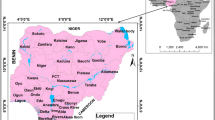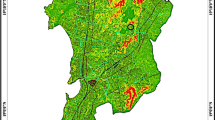Abstract
Conventional methods of groundwater targeting often result in failures due to improper selection of sites as a result of the lack of scientific database. Satellite-based mapping using geographic information system (GIS) has brought a paradigm shift in the mapping of the natural resources including groundwater. Remote sensing is a cost effective technique to carry out the groundwater prospects mapping which otherwise is difficult to achieve at national scale. A comprehensive database could be created on groundwater resource mapping and assessment using IRS LISS III satellite data from IRS-1C and its follow-on missions like IRS-1D and Resourcesat-1 for the entire India which was first of its kind. A national mission called National Rural Drinking Water Program was launched in the year 1999 to carry out groundwater prospects mapping at 1:50,000 scale for the entire country using 23.5 m resolution IRS LISS III satellite data. The objective of the project was to generate groundwater prospects maps on 1:50,000 scale in GIS format showing (a) different prospective zones in terms of yield and depth of aquifer and (b) tentative sites of different recharge structures suitable in the area. It is imperative that the mammoth task of preparing 4898 groundwater prospects maps on 1:50,000 scale for the entire country has become a reality due to the timely and continuous availability of LISS III satellite images from IRS-1C sensor and its follow-on missions.









Similar content being viewed by others
References
Bhattacharya, A. (1991). Remote sensing in hydrogeomorphological mapping. In National workshop on role and status of remote sensing in groundwater prospecting. Hyderabad: NRSC.
CGWB (Central Ground Water Board). (2019). National Compilation on Dynamic Ground Water Resources of India, 2017. Department of Water Resources, RD & GR, Ministry of Jal Shakti, Govt. of India.
Dhiman, S. C. (2012). Aquifer systems of India. New Delhi: CGWB, Ministry of Water Resources, Gov of India.
Falkenmark, M., & Rockström, J. (2006). The new blue and green water paradigm: Breaking new ground for water resources planning and management. Journal of Water Resources Planning and Management, 132, 129–132.
Foster, S. S. D., & Chilton, P. J. (2003). Groundwater: The processes and global significance of aquifer degradation. Philosophical Transactions of the Royal Society of London. Series B: Biological Sciences, 358(1440), 1957–1972.
GEC (Groundwater Estimation Committee). (1997). Report of groundwater resource estimation methodology. New Delhi: Ministry of Water Resources, Government of India.
Jha, B. M., & Sinha, S. K. (2009). Towards better management of groundwater resources in India. Quarterly Journal, 24(4), 1–20.
Kumar, C. P., & Seethapathi, P. V. (2002). Assessment of natural groundwater recharge in upper ganga canal command area. Journal of Applied Hydrology, 15(4), 13–20.
Matahi, J., Das, I. C., Subramanian, S. K., Lenin, K. S., & Dadhwal, V. K. (2015). Coupling geomorphology parameter with lithology for micro-level groundwater resource assessment: A case study from semi-arid hard rock terrain in Tamil Nadu, India. Arabian Journal of Geosciences. https://doi.org/10.1007/s12517-015-1839-y.
MWR. (2002). National water policy. New Delhi: Ministry of Water Resources (MWR), Govt. of India.
NABARD. (2006). Review of methodologies for estimation of groundwater resources of India. Mumbai: Technical Services Department, National Bank for Agriculture and Rural Development (NABARD).
NRSA. (2008). Methodology & technical guidelines for preparation of groundwater prospects maps.
Saha, R., Kumar, G. P., Pandiri, M., Das, I. C., Rao, P. N., Reddy, K. S. N., & Kumar, K. V. (2018). Knowledge guided integrated geo-hydrological, geo-mathematical and gis based groundwater draft estimation modeling in Budhan Pochampalli Watershed, Nalgonda District, Telangana State, India. Earth Science India, 11(4), 216–231.
Shankar, P. V., Kulkarni, H., & Krishnan, S. (2011). India’s groundwater challenge and the way forward. Economic and Political Weekly, 46, 37–45.
Singh, A., Panda, S. N., Uzokwe, V. N., & Krause, P. (2019). An assessment of groundwater recharge estimation techniques for sustainable resource management. Groundwater for Sustainable Development, 9, 100218.
Subramanyam, K., Ahmed, S., & Dhar, R. L. (2000). Geological and hydrogeological investigations in the Maheshwaram watershed. A.P., Technical report no. NGRI 2000—GW-292, Hyderabad, India.
World Bank. (2010). Deep wells and prudence: Towards pragmatic action for addressing groundwater overexploitation in India. Washington: World Bank.
Acknowledgements
We acknowledge the contribution of Dr. D.P. Rao, Dr. R.R. Navalgund, Dr. K Radhakrishnan, Dr. V. Jayaraman, Dr. V.K. Dadhwal, Dr. YVN Krishnamurthy, former Director, NRSC, and Shri Santanu Choudhary, Director, NRSC, Dr. S.K. Bhan, former Ass. Director, NRSC, Dr. P.S. Roy, Shri G. Benhera, Dr V. Raghavaswamy, Dr. V. Bhanumurthy, Former DD, RSA, NRSC, Dr. PVN Rao, DD, RSA, NRSC and entire team of Rajiv Gandhi National Drinking Water Mission Project of NRSC from time to time during a period of 15 years from 1999 to 2014 for successful completion of the project.
Author information
Authors and Affiliations
Corresponding author
Additional information
Publisher's Note
Springer Nature remains neutral with regard to jurisdictional claims in published maps and institutional affiliations.
About this article
Cite this article
Das, I.C., Kumar, K.V., Rajasekhar, D. et al. IRS-1C Satellite Data Utilization for Groundwater Prospects Mapping for the Entire Country Under National Rural Drinking Water Program (NRDWP): A State of the Art Initiative. J Indian Soc Remote Sens 49, 111–120 (2021). https://doi.org/10.1007/s12524-021-01308-7
Received:
Accepted:
Published:
Issue Date:
DOI: https://doi.org/10.1007/s12524-021-01308-7




